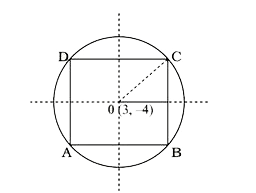A square is incribed in a circle x2+y2−6x+8y−103=0 such that its sides are parallel to co-ordinate axis then the distance of the nearest vertex to origin, is equal to (A) 13 (B) √127 (C) √41 (D) 1
√41
13
√137
6
The correct Answer is:A
Centre of given circle (3,-4) and Radius =8√2
Vertices of inscribed square will be (3±8,−4±8) {∵OP=PC=8√2√2=8}

So, vertex nearest to origin will be (-5,4)
Hence required distance =√41
Similar Questions
A square is incribed in a circle x2+y2−6x+8y−103=0 such that its sides are parallel to co-ordinate axis then the distance of the nearest vertex to origin, is equal to (A) 13 (B) √127 (C) √41 (D) 1
View SolutionA square is inscribed in a circle x2+y2−4x−6y+5=0 whose sides are parallel to coordinate axis then the vertex of the square is/are
View Solution
Knowledge Check
A square is inscribed in the circle x2+y2−2x+4y+3=0 . Its sides are parallel to the coordinate axes. One vertex of the square is (1+√2,−2) (b) (1−√2,−2) (1,−2+√2) (d) none of these
A(1+√2,−2)B(1−√2,−2)C(1,−2+√2)Dnone of theseA square is inscribed in the circle x2+y2−2x+4y−93=0 with its sides parallel to the co-ordinate axes. The co-ordinates of its vertices are
A(-6,-9),(-6,5),(8,-9), (8,5)B(-6,9),(-6,-5),(8,-9), (8,5)C(-6,-9),(-6,5), (8,9),(8,5)D(-6, -9),(-6,5), (8,-9), (8,-5)A square is inscribed in the circle x2+y2−10x−6y+30=0. One side of the square is parallel to y=x+3, then one vertex of the square is
A(3, 3)B(7, 3)C(6,3−√3)D(6,3+√3)
" A square is inscribed in the circle "x^(2)+y^(2)-2x+4y-93=0" with its sides parallel to the coordinates axes one vertex of the square is "
View SolutionA square is inscribed in the circle x2+y2−6x+8y−103=0 with its sides parallel to the coordinate axes. Then the distance of the vertex of this square which is nearest to the origin is
View Solutiona square is inscribed in the circle x2+y2−10x−6y+30=0. One side of the square is parallel to y=x+3, then one vertex of the square is :
View SolutionA square is inscribed in the circle x2+y2−2x+8y−8=0 whose diagonals are parallel to axes and a vertex in the first quadrant is A then OA is
View SolutionA square is inscribed in the circle x2+y2−2x+4y+3=0 . Its sides are parallel to the coordinate axes. One vertex of the square is (1+√2,−2) (b) (1−√2,−2) (1,−2+√2) (d) none of these
View Solution